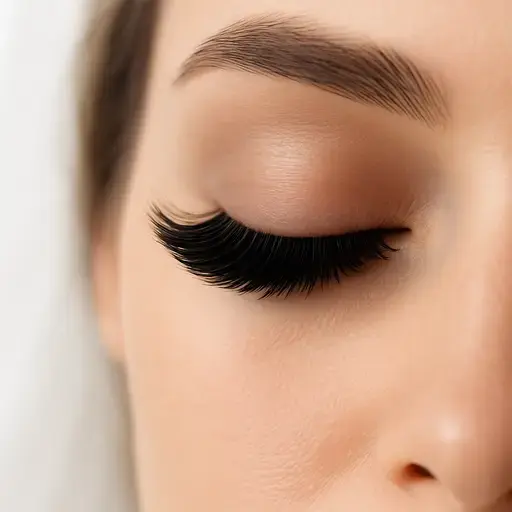What is Nail Fungus?
- delosbeauty
- Jun 2
- 8 min read
Nail fungus is a common nail problem that can easily spread to other parts of the body and can threaten the health of the nails. This disease usually occurs when fungi grow in a moist, dark area under the nail and can cause changes in the color, thickness and shape of the nail. Although nail fungus is usually not serious, it can cause pain, inflammation and cosmetic problems. In this article, we will take a full look at what is nail fungus and treatment strategies for nail fungus so that you can learn about effective treatment methods and prevention of this problem.
What is nail fungus??
Nail fungus is a common type of nail infection, also known as onychomycosis. The infection, which causes your nails to turn yellow and appears as white or brown spots under and on the tips of your nails, can deepen over time, causing your nails to become discolored, thickened, and even the edges of your nails to become brittle.
If the infection is not severe, it is not causing you any problems and you probably do not need treatment. In these cases, you can treat the problem with fast-acting nail fungus medications or over-the-counter medications. However, if the infected area becomes painful and you notice changes in the shape of your nails, it is best to see a specialist and make sure you are taking medication and medical care. Although nail fungus can affect nails, it is more common in toenails.

The important point in all types of nail fungus is that if not treated in time, the fungus can spread to other nails and even the skin of your hands, causing serious problems for you.
Nail Fungus Symptoms
Tırnak mantarı olan kişilerin tırnaklarında en sık görülen ve bunlara bakarak tırnak mantarını teşhis etmeyi kolaylaştıran belirtiler şunlardır:
Thick and horny nails
Nail color change
Nail breakage or irregularity
Nail separation from the nail bed
Bad odor
Causes of Nail Fungus
Most of the time, various fungal organisms that live harmlessly on our skin can sometimes cause nail fungus. The most common type of nail fungus is dermatophyte.
Dermatophyte is a type of fungus that loves dead keratin and is found in nails, hair, and skin, and will grow if conditions are right.
In addition to fungi, yeast, bacteria, and mold can also cause nail infections. It is also good to know that discoloration of nails caused by bacterial infection can appear green or black.
Contact with fungal surfaces such as shower tiles, swimming pools, or gyms can infect your nails. Wearing dark-colored shoes, sweating and moisture in shoes, or using dirty nail tools and products can also cause nail fungus.
In addition, there are other factors that can increase your risk of developing nail fungus in general, including:

Old age; slower than normal blood circulation and thickened nails are factors that cause this problem in older people.
Wearing shoes that cause sweaty feet.
A history of athlete's foot; this is the most common type of fungal infection among athletes.
Walking barefoot in public, damp places such as swimming pools and gyms.
Minor damage to the skin or nails that is not noticeable.
Having a skin condition such as psoriasis that affects the nails. Remember that psoriasis is not a fungal infection and only makes the nails vulnerable.
Having diabetes, blood flow problems or a weakened immune system.
Prevention of nail fungus
The good news is that you can prevent nail fungus with a few simple steps. All you need to do is:
Keep your nails clean and dry.
Wash your hands and feet regularly. Don’t forget to wash and dry your hands thoroughly after touching an infected nail.
Long nails are more likely to develop nail fungus, so it’s best to keep your nails as short as possible. File the edges of your nails and pay attention to thickened areas.
Nail clippers are a very personal tool. After each use, thoroughly disinfect your nail clippers with alcohol or betadine or another disinfectant.
Wear antiperspirant socks throughout the day, and be sure to change your socks if your feet get sweaty.
Wearing shoes made of the right material is very effective in controlling nail fungus. You can also use disinfectant powders or antifungal powders.
Wear appropriate, preferably open-toed, slippers in public places such as the pool or locker room.
For nail repairs or extensions, be sure to sterilize salon manicure and pedicure tools. If you use special tools for at-home pedicures, be sure to thoroughly disinfect them. If your nails are affected, avoid using nail polish and artificial nail glue until they are completely healed.
Nail Fungus Treatment
You don’t always have to resort to fancy, complicated methods to treat nail fungus. Sometimes, using over-the-counter products (available at pharmacies) can help control nail fungus.
However, if your type of nail fungus doesn’t improve with over-the-counter products, you should definitely see a doctor. Keep in mind that this treatment can take months.
Home treatment for nail fungus
Fungal nail infections can usually be treated by following the steps mentioned above and using over-the-counter antifungal and antimicrobial products. However, if you want to solve this problem using home remedies, we will learn more about some home remedies below.
1. Vicks
You are probably familiar with the smell of Vicks; it is a strong eucalyptus-scented ointment used to relieve bone pain and help with coughs during colds. According to a 2011 study, this ointment has been proven to have positive therapeutic effects in treating toenail fungus. Of course, we said that the main use of this ointment is to treat coughs, but the ingredients used in it, such as eucalyptus oil, help treat toenail fungus. All you need to do is apply this ointment to the affected area at least once a day.
2. Zanthophyllum plant extract
Zaravand plant is known in traditional medicine as one of the effective herbs for treating fingernail and toenail fungus at home. This plant belongs to the sunflower family and is a well-known plant in many parts of the world. According to various studies and clinical trials, creams made with the extract of this plant have a great effect in treating various types of nail fungus, as well as nail fungus problems in diabetics. Currently, antifungal ointment of this plant is available in pharmacies as a nail fungus remedy.

3. Tea tree oil
One of the most important properties of tea tree oil is its antifungal and antiseptic properties. This oil is used in many parts of the world as a versatile medicine to control and treat all kinds of wounds, skin fungus, burns, etc. To use the properties of tea tree oil in treating nail fungus, you can apply this oil to the affected and damaged area once or twice a day.
4. Oregano oil
Oregano oil contains a chemical called thymol; this antibacterial compound is also found in other herbs like oregano. To treat toenail and finger nail fungus at home with oregano oil, apply the oil to the affected nail twice a day.
You can mix oregano and tea tree oil for added effect. Of course, make sure to do a patch test before using. Combining these two types of oils can cause an allergic reaction.
5. Listerine mouthwash
Yes! You read that right, Listerine mouthwash. This gargle contains menthol, thymol, and eucalyptus and has powerful antibacterial and antifungal properties, making it a great home remedy for nail fungus. Soak the affected toenail in a container of diluted Listerine for 30 minutes daily.
6. Garlic
Studies have shown that garlic extract has antifungal properties. Nail fungus can be treated by applying crushed or minced garlic cloves to the affected nail. Leave the extract on for 30 minutes. If you don’t like the smell of garlic, you can use garlic capsules, which are much less odorous than fresh garlic.
7. Apple cider vinegar
Apple cider vinegar is also known to be an effective treatment for toenail fungus. Due to its powerful antimicrobial properties, this vinegar is one of the home remedies used to treat nails damaged by nail fungus. Soak the affected toenail in a solution of warm water and vinegar for 20 minutes to combat nail fungus with this simple home remedy.

Medicine for nail fungus
When you see a doctor, you will be prescribed different types of antifungal medications depending on the extent of nail involvement. Do not use these medications without a doctor's advice or prescription.
Oral antifungal medications:
Various oral antifungal medications are often considered doctors’ first choice for rapid treatment of nail fungus. One of these medications is itraconazole (Sporanox). The course of taking this medication is 6 to 12 weeks, during which time a new nail slowly grows in place of the damaged and fungal nail. The final result of the treatment will be determined after the drug treatment is completed.
Medicated nail polish:
Another option that your doctor may prescribe for treating nail fungus is to use various types of antifungal nail polish. To use this nail polish treatment, you need to apply the nail polish to the infected nail and the surrounding skin once a day. After seven days, clean the layers of the nail with alcohol and repeat the process. Sometimes, you may need to use this nail polish for nail fungus every day for a year to get a full cure.
Nail Fungus Ointment:
Among the most powerful antifungal nail ointments, antifungal ointments such as Ofinaconazole and Tobramycin are two effective over-the-counter medications for treating nail fungus. To use nail fungus ointment, you should first moisten your nails lightly and then apply the medication to the affected area. Be sure to read the instructions on the back of the package for best results.

Surgery to treat nail fungus
Sometimes none of the above treatments for nail fungus may be effective. In this case, surgical removal of the nail and subsequent treatment of the fungal area will be the only solution. Therefore, if there is no change in the condition of your nails after using medication or home remedies for a while, be sure to see a doctor and do not give up until the treatment is completed.
In order to treat and cure nail fungus, you should be patient and be aware that your nail fungus infection may reoccur even after treatment.
People with diseases such as diabetes are more likely to get nail fungus than others. It is better to take our recommendations for preventing nail fungus seriously and take the best care of your nails or apply nail strengtheners and other mentioned tips.
Final Advice for Treating Nail Fungus
Finally, if not diagnosed and treated in a timely manner, nail fungus can cause more serious problems, such as damaging the nail structure and even spreading the infection to other parts of the body. Treatment options for nail fungus include topical antifungal medications, creams, laser therapy, and in some cases, oral medications. Additionally, following hygiene tips, such as keeping your nails dry and wearing proper shoes, can prevent this infection. If you notice signs of nail fungus, such as changes in the color, thickness, or odor of your nails, it is best to see a doctor as soon as possible to begin appropriate treatment and prevent the spread of the disease.
Questions and Answers:
Is toenail fungus dangerous?
Toenail fungus is usually not dangerous, but if left untreated it can damage the nail and cause the infection to spread.
Can nail fungus spread to other nails?
People with weak immune systems, athletes, and people who are frequently exposed to humid environments are more prone to nail fungus.
Who is most at risk of nail fungus?
Yes, nail fungus can spread to other nails and even the surrounding skin.
Is nail fungus dangerous?
If treated, there is no risk to health.




Comments